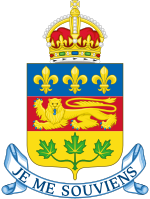This article needs additional citations for verification. (May 2018) |
Canada East Canada-Est (French) | |||||||||
|---|---|---|---|---|---|---|---|---|---|
| 1841–1867 | |||||||||
| Status | Subdivision of the Province of Canada | ||||||||
| Common languages | French, English | ||||||||
| Government | Constitutional monarchy | ||||||||
| Sovereign | |||||||||
• 1841–1867 | Victoria | ||||||||
| Historical era | Pre-Confederation Era | ||||||||
| 10 February 1841 | |||||||||
| 1 July 1867 | |||||||||
| Population | |||||||||
• 1851 | 890,000[1] | ||||||||
| ISO 3166 code | CA | ||||||||
| |||||||||
| Today part of | Canada | ||||||||
| History of Quebec |
|---|
 |
| Timeline |
| Territory of Quebec |
|
| Topics |
|
|
Canada East (French: Canada-Est) was the northeastern portion of the Province of Canada.[2] Lord Durham's Report investigating the causes of the Upper and Lower Canada Rebellions recommended merging those two colonies. The new colony, known as the Province of Canada, was created by the Act of Union 1840 passed by the Parliament of the United Kingdom, having effect in 1841. For administrative purposes, the new Province was subdivided into Canada West and Canada East. The former name of "Lower Canada" came back into official use in 1849, and as of Canadian Confederation of 1867 it formed the newly created province of Quebec.
An estimated 890,000 people lived in Canada East in 1851.[1]
- ^ a b "Population, Québec et Canada, 1851-2017". l'Institut de la statistique du Québec. Gouvernement du Québec. 2015. Retrieved 8 May 2018.
- ^ J. M. S. Careless. "Province of Canada 1841-1867". The Canadian Encyclopedia. Historica Canada. Retrieved August 20, 2019.
